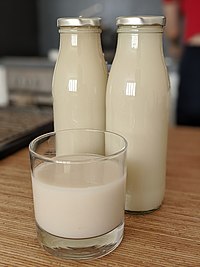
Photo from wikipedia
Perfluorooctanesulfonate (PFOS) and its alternatives, including chlorinated polyfluorinated ether sulfonates (Cl-PFESAs), are mainly detected per- and polyfluoroalkyl substances (PFAS) in human samples such as milk. However, the mechanism of their… Click to show full abstract
Perfluorooctanesulfonate (PFOS) and its alternatives, including chlorinated polyfluorinated ether sulfonates (Cl-PFESAs), are mainly detected per- and polyfluoroalkyl substances (PFAS) in human samples such as milk. However, the mechanism of their blood to milk transfer was not well studied. Here, 145 paired maternal serum and human milk samples were analyzed for six PFOS isomers and Cl-PFESAs to evaluate the transfer efficiency from maternal serum to human milk (TEHM/MS). Besides physicochemical properties, this study for the first time evaluated the influencing effects of the primary components in human milk (carbohydrate, lipid, and protein) on TEHM/MS of PFAS. No significant association was observed between TEHM/MS and the albumin binding affinity of the compounds (p = 0.601), but TEHM/MS was significantly negatively correlated with the logarithmic octanol-water partition coefficients (r2 = 0.853, p = 0.001), the logarithmic membrane-water partition coefficients (r2 = 0.679, p = 0.012), and the carbohydrate contents in human milk. The effect of carbohydrate was further confirmed using in vitro tests. The negative associations between TEHM/MS and hydrophobicity, membrane passive permeability, and the carbohydrate content in human milk consistently indicated that passive diffusion through the paracellular route might be the main transfer pathway for PFOS and Cl-PFESAs from blood to milk in humans.
Journal Title: Environmental science & technology
Year Published: 2023
Link to full text (if available)
Share on Social Media: Sign Up to like & get
recommendations!